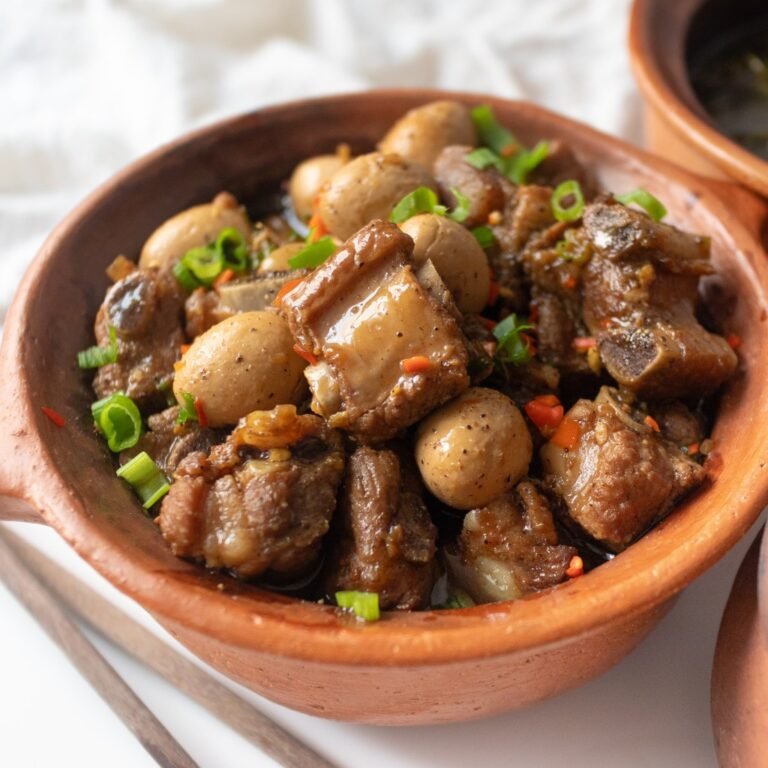It is sometimes called the shoujo, sometimes called the shoujo.
This Vietnamese dish consists of a spare rib of soft bite-sized pork and slowly warped quail eggs, which are slowly simmered in a flavorful sauce.
It is similar to khotàu. Instead of pork belly, there are pork spear ribs. Instead of chicken eggs, quail eggs are smaller. And instead of a lot of sauce, we don’t have much here, just a little for a nice drizzle or glaze.

This is a traditional Vietnamese home-cooked dish that was rarely found in Vietnamese restaurants in the US. Served in a family style with other dishes, they are always paired with steamed white rice. The food is rich and flavorful, perfectly balanced and sweet and delicious.
This dish didn’t grow very often as pork spear ribs are considered expensive cuts. Do you have time to peel off fresh quail eggs when your parents are always working and tired?
But when we have it, this is the kind of dish that you feed with your hands just to get the last meat from the bones. It’s literally okay to put your finger on. And this is how you can make it at home.


What you need
To cut the Suon Rim Trung, collect the following ingredients:
Pork spear ribs: Pick up these at Asian grocery stores, but perhaps they’re already in a series of riblets. Take them home, cut into the bones and get bite-sized pork ribs. Quail Eggs: They quickly absorb the sauce beautifully. You can usually find fresh quail eggs in the refrigerated section of an Asian grocery store. If quail eggs are not available, substitute canned quail eggs or fresh chicken eggs. Aromatic: shallots and garlic are aromatic in Vietnamese cuisine. Peel and chop finely and then set aside. It also uses green onion (also known as Scallion). Slice it thinly and keep the white and green separately. The white part is used as a fragrance, while the green part is reserved for decoration. Neutral oil: A small amount is enough to fry the air freshener. Seasonings and Decorations: There are many ways to season Vietnamese steamed dishes. Keep it simple with fish sauce, sugar and ground black pepper. This recipe also adds chicken bouillon powder (hạtnêm/bộtnêm). Decoration: To garnish the edges, apply a little more sprinkle black pepper and a green part of the green onion. If it’s spicy, use red chicken chili peppers as well. Please choose your choice. Store-buyed convenient caramel sauce (Nuoc Mau): used in many Vietnamese dishes to add a deep colour. You can substitute pre-made soy sauce or rich soy sauce, or make it yourself. Sugar: Adds sweetness and helps to make shiny glazes during the braising process. Water: Traditionally made with fresh Vietnamese coconut juice or in the US as a quick replacement with coconut soda (such as cocolico). For this recipe, I keep it simple with plain water.
How to make it
Step 1: Preparation
Start by bringing medium water to a boil. Use the same water to warm the pork ribs. This helps to remove impurities such as blood and bone fragments that can make the source appear to Gankey.
Boil the quail eggs for 5 minutes, then transfer to an ice bath to cool. Peel the skin and set it aside.
Cut the spare rib into bite-sized pieces. Blanch them in boiling water for 3 minutes or until scum rises. Drain the ribs through the sink colander and rinse under cold running water until they are clean.
Step 2: Toast Aroma
If you want to reuse the same thing, clean the pot. Add oil and heat to medium height. Add shallots, garlic and white green onion. Fry for about 15 seconds or until fragrant and lightly toasted.

Step 3: Cover and stew
Add brunch pork rib and toss and coat it with aromatics. Add chicken broth, fish sauce, oyster sauce, ground black pepper, caramel cooking syrup and sugar. Throw it on the court. Add water. Cover with medium low stew for 30 minutes and simmer.

Step 4: Clear and reduce
Remove the lid, add the sturdy quail eggs, gently throw them and sprinkle them over the sauce. Continue cooking for about 15 minutes or until the sauce is half-in-half. Don’t forget to turn the pork ribs and quail eggs from time to time to ensure a uniform colour.


Step 5: Finish
Serve with remaining green onions, excess ground black pepper and chili pepper, and garnish with chili pepper if it’s spicy.
Move to the serving platter and serve hot steamed white rice and optional vegetable side dishes for a complete meal.

Quail egg skin tip
There are plenty of tips for peeling sturdy eggs. In my experience, some tips don’t work, such as adding salt or vinegar to the water or penetrating the eggs. Help is to pray slowly and a little bit along with these steps.
Ice bath after boiling
Once it boils, immediately transfer the eggs to an ice bath and allow them to cool enough to handle.
It will break evenly
Gently roll the eggs on the counter under light pressure. This will break the eggshell more evenly and completely. Return them to ice water so that water can be obtained between the shells.
Skin from the wide edge (most important!)
The wide edge of the egg is usually where the air pocket is located. This is the only time you use your fingertips. Go deeper and grab the membrane under the shell. Lift slowly, then peel off the eggs from this point without using your fingertips. The rest of the shell should come off with a strip. Rinse the peeled eggs and remove any remaining shells.

Storage and reheat
Like many stewed dishes, this tastes even better the next day after the time has passed for the flavor to blend. For this reason, you’ll be considering double or tripling your recipe and have plenty of leftovers.
Store in the fridge for up to 3 days and gently reheat over low heat in the top of the stove or in the microwave. This dish is perfect for lunch or meal preparation at work!
printing
Clock Clock iconcutlery Cutlery Icon Flag Flag Icon Folder Folder Folder ICONINSTAGRAMINSTAGRAMS ICONPINTEREST PINTEREST PINTEREST ICONFACEBOOK Facebook ICONPRINT PRINT ICONSQUARES SQUARES ICONHEART HEART HEART ICONHEARE
explanation
A soft, sweet and tasteful pork rib bone served with a sturdy boced quail egg, perfect in a bowl of hot steamed rice.
Preparation: Bring medium water to a boil. Boil the quail eggs for 5 minutes, then transfer to an ice bath to cool. Peel the skin and set it aside. Cut the pork spear ribs into bite-sized pieces. Blanch in boiling water for 3 minutes or until scum rises. Drain and rinse under cold running water until it is clean. Toast Freshener: Clean the pot if you want to reuse it. Heat the oil over medium-high heat. Add shallots, garlic and white green onion. Fry until fragrant for about 15 seconds. Cover and Braised: Add brunch pork rib bones and toss to coat with aromatics. Stir in chicken broth, fish sauce, oyster sauce, ground black pepper, caramel cooking syrup and sugar. Add water over medium and low heat for 30 minutes, cover and simmer. Cover and GL: Remove the lid, add the hardened quail eggs, and gently throw to coat. Cook for about 15 minutes or until sauce is half full. Sometimes I turn even colors. Add taste tests and fish sauce if necessary. Finish: Garnish with remaining green onions, excess ground black pepper and optional chili pepper. Heat steamed rice and vegetable side dishes for a complete meal.
Preparation time: 15 minutesCooking time: 45 minutescategory: Side dishmethod: Stove topcooking: Asian and Vietnamese people
(TagStoTranslate)Stewed (T)Caramelized (T)Classic (T)Fish sauce (T)Popular (T)Pork ribs (T)Quil egg (T)Spare ribs (T)Vietnamese


